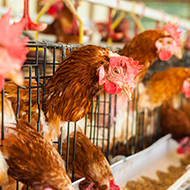Avian flu virus in fur farm outbreak adapted to mammals
A total of 27 fur farms were affected by avian flu during the outbreak last year.
The vulnerability of fur farms to avian influenza viruses could increase the virus’ pandemic potential, a new study has suggested.
Between July and October 2023, the H5N1 strain of highly pathogenic avian influenza (HPAI) was confirmed in fur animals on 27 fur farms in Finland.
Although some of the infected mammals were asymptomatic, in others it caused fatal pneumonia and meningitis. Neurological symptoms were more common than respiratory symptoms.
In response to the outbreak, authorities in Finland quickly implemented control measures, including culling infected animals and introducing stronger biosecurity requirements on fur farms.
Analysing virus samples, the researchers found that the outbreak was likely caused by large-scale direct exposure to infected wild birds. According to the researchers, this highlights the importance of robust biosecurity measures.
The analysis also revealed genetic mutations which are associated with increased adaptability to mammals. During the outbreak, there was likely transmission of the virus between fur animals.
The genetic adaptions mean that outbreaks in fur farms could potentially pose a future risk to human health, the researchers suggest.
The study concluded: ‘Although prevention of outbreaks is the main target, improving preparedness and response capacity of both fur farms and authorities is essential, as well as being alert for any increase in mortality on the farms.
‘Virological surveillance designed for early detection of outbreaks is an essential part of disease control and we recommend active monitoring, especially when HPAI is found in bird populations in the vicinity of animal farms.
‘The importance of implementing safer fur farming practices is highlighted by the observations of genetic changes during the outbreak associated with mammalian adaptation, which may increase the pandemic potential of the circulating avian influenza viruses.’
The study has been published in the journal Eurosurveillance.
Image © Shutterstock



 An Avian Influenza Prevention Zone (AIPZ) has been introduced across Wales.
An Avian Influenza Prevention Zone (AIPZ) has been introduced across Wales.